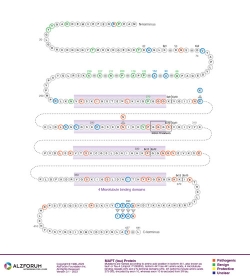Mutations
MAPT Duplication 17q21.31
Quick Links
Overview
Pathogenicity: Other Tauopathy : Pathogenic
Clinical
Phenotype: Alzheimer's Disease
Reference Assembly: GRCh37/hg19
dbSNP ID: NA
Coding/Non-Coding: Both
DNA
Change: Duplication
Genomic
Region:
Findings
The 17q21.31 microduplication is a copy number variant encompassing the CRHR1, MAPT, STH, and KANSL1 genes.
This duplication was found in four index cases in a cohort of 546 unrelated patients of French ancestry initially diagnosed with early onset Alzheimer’s disease. Two of the index cases were sporadic, while the other two had a family history of AD. One of the sporadic index cases appeared to have a de novo duplication event, as his parents were not carriers. Another index case had a first cousin once removed who also was a duplication carrier and was diagnosed with early onset AD. Unaffected relatives did not have the duplication, suggesting segregation with disease. The five patients with the 17q21.31 duplication developed progressive cognitive decline and memory deficits. The average age of onset was 52.6 years with a range of 45-58 years (Le Guennec et al., 2016).
CSF biomarkers were available from the index cases showing that total tau and phosphorylated tau were elevated and three of the four cases also had reduced Aβ42 levels. Structural imaging revealed bilateral hippocampal atrophy in all the cases. Amyloid PET scans did not find evidence of amyloid plaques in three of the index cases. There was no PET imaing for the fourth individual.
Individuals with C9ORF72 repeat expansions, APP duplication, or mutations in APP, PSEN1, or PSEN2 were not included in this study. The 17q21.31 duplication was absent from 597 controls. Additionally, only four individuals with the duplication were found while searching databases and previously published studies with more than 50,000 subjects. Three of the patients were homozygous for APOE3 and the other two were heterozygous APOE4/APOE3.
Another family reported in the literature for its AD-like dementia was also found to have the 17q21.31 duplication (Alexander et al., 2016; Le Guennec et al., 2016). Four individuals from three generations of this family developed progressive cognitive decline including, behavioral changes, memory impairment, and executive dysfunction. Two of the affected individuals were available for genetic testing and had the 17q21.31 duplication, while an unaffected relative did not. Medial temporal lobe atrophy was also reported.
Neuropathology
Neuropathological analysis from the last family showed neurofibrillary tangles in the hippocampus, entorhinal cortex, and nucleus basalis of Meynert. Phosphorylated TDP-43 was observed in dendrites, but Aβ and α-synuclein immunostaining was negative (Alexander et al., 2016).
Biological Effect
The genomic duplication was associated with a 60-90 percent increase in the mRNA levels of MAPT.
Last Updated: 14 Jul 2017
References
Paper Citations
- Le Guennec K, Quenez O, Nicolas G, Wallon D, Rousseau S, Richard AC, Alexander J, Paschou P, Charbonnier C, Bellenguez C, Grenier-Boley B, Lechner D, Bihoreau MT, Olaso R, Boland A, Meyer V, Deleuze JF, Amouyel P, Munter HM, Bourque G, Lathrop M, Frebourg T, Redon R, Letenneur L, Dartigues JF, Martinaud O, Kalev O, Mehrabian S, Traykov L, Ströbel T, Le Ber I, Caroppo P, Epelbaum S, Jonveaux T, Pasquier F, Rollin-Sillaire A, Génin E, Guyant-Maréchal L, Kovacs GG, Lambert JC, Hannequin D, Campion D, Rovelet-Lecrux A. 17q21.31 duplication causes prominent tau-related dementia with increased MAPT expression. Mol Psychiatry. 2016 Dec 13; PubMed.
- Alexander J, Kalev O, Mehrabian S, Traykov L, Raycheva M, Kanakis D, Drineas P, Lutz MI, Ströbel T, Penz T, Schuster M, Bock C, Ferrer I, Paschou P, Kovacs GG. Familial early-onset dementia with complex neuropathologic phenotype and genomic background. Neurobiol Aging. 2016 Jun;42:199-204. Epub 2016 Mar 21 PubMed.
Further Reading
No Available Further Reading
Protein Diagram
Primary Papers
- Le Guennec K, Quenez O, Nicolas G, Wallon D, Rousseau S, Richard AC, Alexander J, Paschou P, Charbonnier C, Bellenguez C, Grenier-Boley B, Lechner D, Bihoreau MT, Olaso R, Boland A, Meyer V, Deleuze JF, Amouyel P, Munter HM, Bourque G, Lathrop M, Frebourg T, Redon R, Letenneur L, Dartigues JF, Martinaud O, Kalev O, Mehrabian S, Traykov L, Ströbel T, Le Ber I, Caroppo P, Epelbaum S, Jonveaux T, Pasquier F, Rollin-Sillaire A, Génin E, Guyant-Maréchal L, Kovacs GG, Lambert JC, Hannequin D, Campion D, Rovelet-Lecrux A. 17q21.31 duplication causes prominent tau-related dementia with increased MAPT expression. Mol Psychiatry. 2016 Dec 13; PubMed.
Disclaimer: Alzforum does not provide medical advice. The Content is for informational, educational, research and reference purposes only and is not intended to substitute for professional medical advice, diagnosis or treatment. Always seek advice from a qualified physician or health care professional about any medical concern, and do not disregard professional medical advice because of anything you may read on Alzforum.


Comments
No Available Comments
Make a Comment
To make a comment you must login or register.